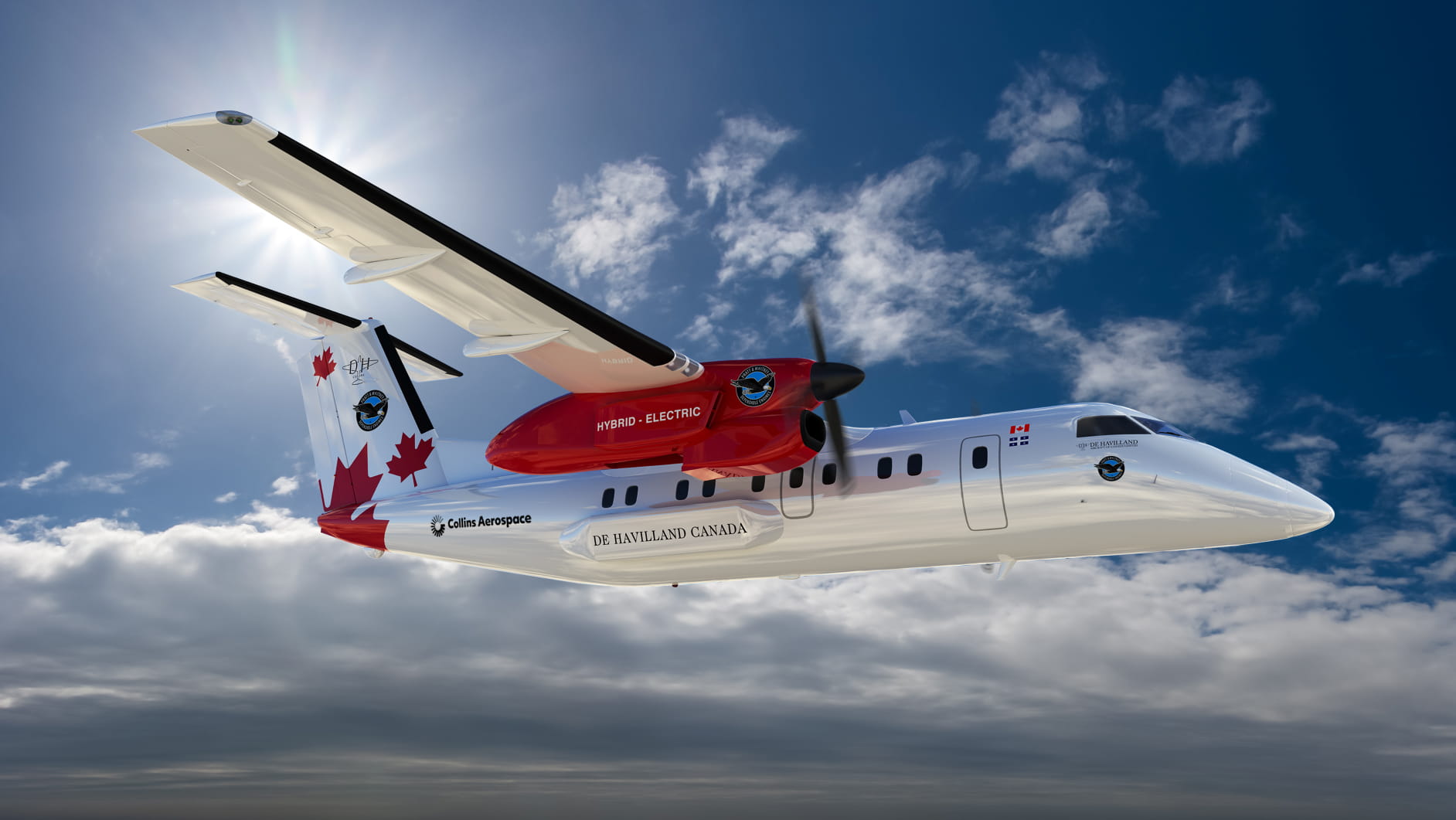Electrification
Around the world, the move to more electric technologies is driving a more sustainable future. And in the skies, it’s no different. As a leader in aircraft electric systems, Collins is continuously investing in technologies to create a more electric aircraft that can help reduce fossil fuel burn and emissions and push us farther along toward zero emissions propulsion.
More electric systems
By replacing traditional hydraulic and pneumatic systems with electric systems, we can reduce bleed air required from the engine and enable greater engine efficiency and lower fuel consumption. Collins already has significant experience in the development of these systems and manufactures the only bleed-less electric environmental control system in service today for the Boeing 787 Dreamliner. Providing an environmental control system that uses outside air instead of engine bleed air supports the 787 in significantly reducing fuel burn and therefore carbon emissions.
Learn more about how we're advancing more electric systems and hybrid-electric propulsion in The Power of Electric Flight, featuring Power & Controls president Henry Brooks.
Hybrid-electric / electric propulsion
As with the automotive industry, providing gas-powered engines with electric assistance can go a long way in making a platform more sustainable. For aviation, breakthrough electric propulsion systems must not only be scalable, efficient and affordable – they must be safe and pass rigorous certification testing.
With this in mind, we’ve invested heavily in research and development of hybrid-electric propulsion technologies.
- We’re working to design and test a 1 megawatt motor, motor controller and battery system – expected to be the aerospace industry’s most power-dense and efficient to date.
- Our advanced electric motor and controller will enable a Pratt & Whitney Canada (PWC) engine on a De Havilland Dash-8 100 regional aircraft, hybrid-electric flight demonstrator that PWC is working on with De Havilland Aircraft of Canada (De Havilland), a division of Longview Aviation Capital.
- In 2019, we initiated the build of a state-of-the-art electric systems lab called the GRID in Rockford, Illinois to test emerging technologies – such as the 1 megawatt motor system mentioned above -- at every step of the development process in simulated flight conditions.
- We’re looking at alternative sources of power for the next generation of propeller-enabled engines, including hybrid systems that use an electronic engine controller and integrated machine intelligence to optimize electricity and available battery capacity.
- And, in the U.K., we’re working with the University of Nottingham on a rollout placement of four, fuel-burning engines with 500-kilowatt electric motors for Hybrid Air Vehicles' Airlander hybrid airship – another positive step along the path toward fully electric, zero-emission flight.
Next generation propeller systems
Innovations in propeller design, like those we see in our enhanced Collins NP2000, are another way we’re working on fuel and cost efficiencies.
By enabling a 20% increase in thrust, our NP2000 propeller allows aircraft to take off on shorter runways or from higher altitude runways. It also enables aircraft to use lower power settings on longer runways, which reduces fuel burn. The increased efficiency also helps with fuel savings during cruise operations.
Whether propeller-enabled engines are burning sustainable fuel or hydrogen in the future or are replaced with electric motors or hybrid-electric systems, propeller aircraft can play a large role in reaching fleet sustainability goals.
It’s one reason Collins has, along with the support of the French government and local communities, and in collaboration with local industry, made a significant investment in the Collins Propeller Systems in Figeac, France. The center’s mission is to find innovative ways to design and manufacture more sustainable, next-generation propeller systems for turboprop, engine-powered aircraft.
Sustainable Aviation Fuels (SAF)
Sustainable Aviation Fuels, or SAFs, are fuels that come from a variety of power-derived or plant-based materials that can be sourced in a sustainable manner – that is, in a way that does not threaten food crops, forests or interfere with existing water resources.
SAFs are major enablers toward reaching carbon neutrality for aviation, which is why Collins – in collaboration with our sister business, Pratt & Whitney, as well as our customers and industry partners, is actively developing systems and solutions to enable 100% SAF-ready engines and aircraft.
The greatest challenges in introducing these fuels are industry-wide collaboration to ensure proper funding, research, production capacity and accessibility, and a robust implementation strategy. Of all these, scalability of SAF production to the necessary volume – especially considering the other transportation sectors that will be vying for the same fuel stocks -- is the biggest hurdle.
Learn more about SAFs in our white paper, Fueling the Future of Aviation: The Critical Role of Sustainable Aviation Fuel in the Future of Aerospace.
Hydrogen
Hydrogen is one of the few zero-carbon solutions for aviation, if produced sustainably, or with what is referred to as “green electricity.” That’s why the aviation industry is investing more and more in hydrogen R&D, and why we may see hydrogen-fueled aircraft enter into service in the next 15 to 25 years.
But hydrogen can’t be stored the same way as conventional jet fuel. Making it so aircraft can use hydrogen optimally, whether in fuel cells or engine combustion -- two areas we’re exploring right now -- requires significant modifications to airframes and seamless collaboration among airframers, aircraft system providers and propulsion providers.
Much like SAFs, hydrogen will also require new infrastructure efforts by energy companies and governments around the world to enable its adoption.
The prospect of enabling a hydrogen-powered aircraft is exciting – and daunting. Innovation always is. But the reach of Collins’ systems and technology across the aircraft puts us in a unique position to collaborate with customers on hydrogen solutions and other alternative power sources.
Together, we quite literally have the power to transform aviation.
Contact us to learn more about sustainability at Collins Aerospace

